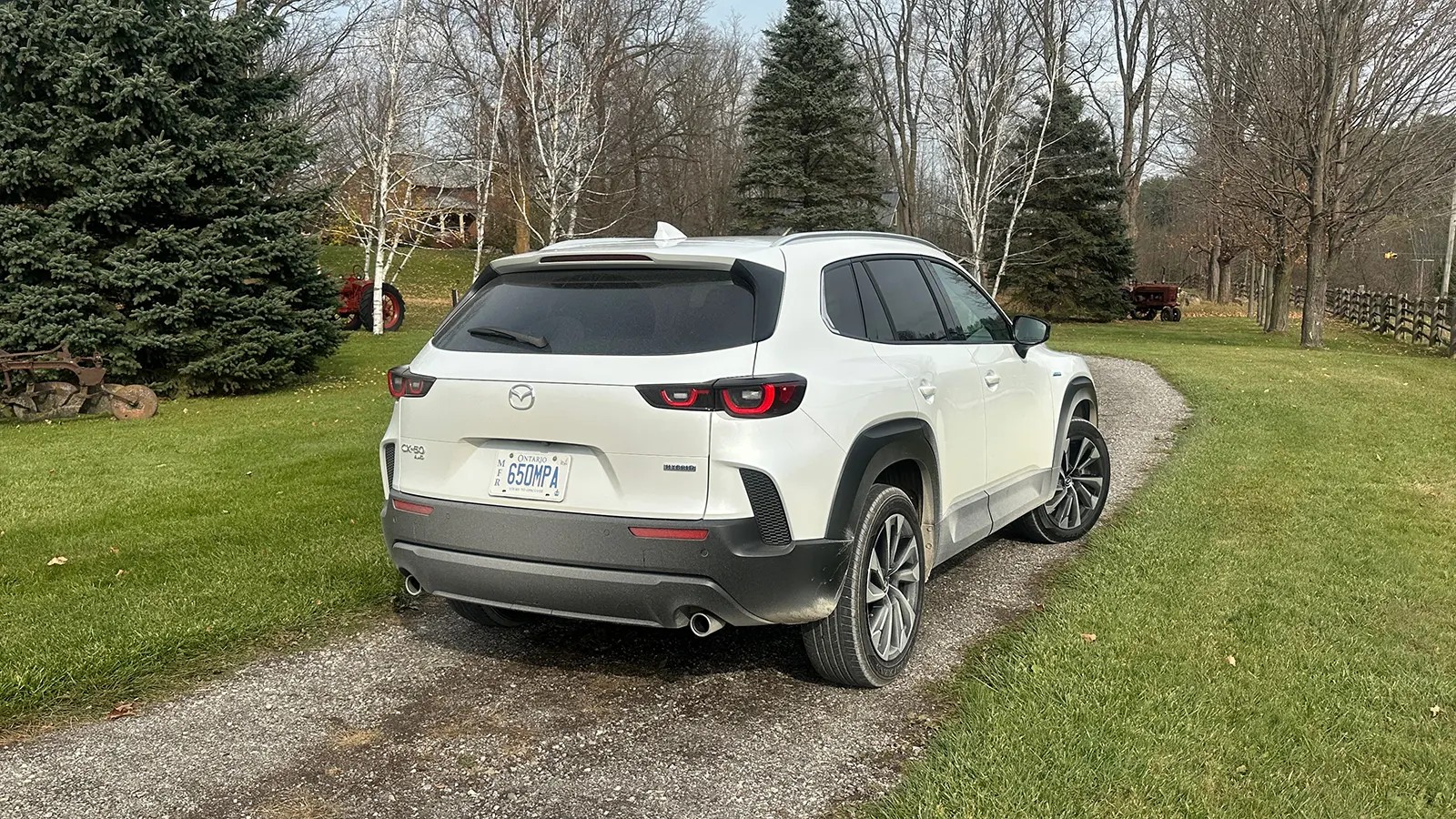The automotive world is buzzing about electric vehicles, but let’s not overlook the impressive advancements in hybrid technology. For drivers seeking fuel efficiency without the need for plugging in, the latest generation of hybrid crossovers presents a compelling option. These gas-electric vehicles utilize regenerative braking and smart engine management to maximize fuel savings, offering a significant step towards electrification without completely changing driving habits.
Hybrid technology, pioneered over two decades ago, has matured significantly. Today’s hybrid crossovers offer improved transmissions, sophisticated computer controls, and enhanced overall performance. While not emissions-free, they are an excellent choice for urban dwellers and those without easy access to charging, providing a practical entry point into the world of electric vehicles. If you’re considering a move towards greener driving, these updated and all-new hybrid crossovers are worth a serious look.
Mazda CX-50 Hybrid: Refined Efficiency Meets Upscale Design
The Mazda CX-50 has already carved out a niche with its rugged aesthetic, offering a more adventurous alternative to the popular CX-5. Now, the 2025 CX-50 Hybrid takes things a step further by incorporating Toyota’s highly respected hybrid powertrain. Underneath its distinctive body, you’ll find the same robust 2.5-liter inline-four engine and CVT (continuously variable transmission) system found in the Toyota RAV4 Hybrid, delivering 219 horsepower and 163 lb-ft of torque. This powertrain, coupled with three electric motors and standard electric all-wheel drive, prioritizes fuel efficiency over outright power.
Compared to the standard gasoline CX-50, the hybrid variant offers more horsepower but less torque, and significantly less of both than the turbocharged CX-50. This clearly positions the CX-50 Hybrid as an efficiency-focused model, contrasting with rivals like the Hyundai Tucson Hybrid, which offers a sportier N-Line trim. The Mazda CX-50 Hybrid achieves a combined fuel economy of 38 mpg, slightly less than the RAV4 Hybrid’s 39 mpg.
Integrating the Toyota Hybrid System (THS) into the Mazda CX-50 involved considerable engineering. Beyond the subtle “Hybrid” badging, Mazda has extended the body cladding and increased the roof height to maintain a 7.6-inch ground clearance, even with the traction battery positioned under the rear seats. While the CX-50 Hybrid is longer than many competitors, its cargo space is slightly reduced to 29.2 cubic feet compared to the standard CX-50’s 31.4 cubic feet, and less than the RAV4 and Tucson Hybrids.
Where the CX-50 Hybrid truly excels is in its interior. Mazda has created a subtly luxurious ambiance, particularly in higher trims. The Premium Plus model boasts two-tone leather seats with meticulous camel-colored stitching, echoed throughout the doors and dashboard. A rotary controller, a feature often found in luxury vehicles, minimizes fingerprints on the touchscreen and complements the convenient steering wheel controls. Additional buttons near the steering column offer access to memory seat settings, a camera for tight maneuvers, and a parking sensor deactivation for car washes.
The panoramic sunroof, standard on all but the base model, adds to the airy feel, while the analog gauges and relatively modest infotainment screen offer a touch of classic appeal. The ride quality and cabin quietness of the CX-50 Hybrid are notably refined, exceeding expectations for a Toyota-derived hybrid system. This hybrid crossover presents a more sophisticated and fuel-conscious Mazda, leaving behind the sporty paddle shifters and turbo engines for other CX-50 versions.
Priced between $34,000 and $40,000 MSRP, the CX-50 Hybrid occupies the middle ground in the CX-50 lineup, positioned above the standard gasoline models but below the more performance-oriented Turbo versions. This contrasts with the Hyundai Tucson, which offers a broader range of hybrid options at similar price points, catering to both efficiency and performance enthusiasts.
Hyundai Tucson Hybrid: A Versatile Hybrid Crossover for Every Taste
Hyundai takes a broader approach with its popular Tucson, offering a spectrum of choices including gas-only, sporty, and luxury-focused hybrid trims, as well as a plug-in hybrid variant. The Tucson PHEV is ideal for those prioritizing electric driving, offering 33 miles of all-electric range for daily commutes while retaining the security of a gasoline engine for longer journeys.
The Tucson Hybrid N Line model stands out with its sporty accents, including unique 19-inch wheels, black side mirrors, and twin-tip exhaust. For 2025, all Tucson models receive a refreshed front fascia with updated LED lighting and wheel designs, enhancing its already sharp and modern styling that sets it apart from more traditionally styled competitors.
Inside, the Tucson N Line boasts a contemporary, fully digital dual-screen setup, replacing traditional gauges. Red stitching accents highlight the sporty seats, doors, center armrest, and steering wheel, complemented by polished pedals and an N-branded steering wheel. This sporty aesthetic is backed by a responsive 1.6-liter turbocharged engine, producing a combined 231 horsepower and 258 lb-ft of torque on premium fuel (regular fuel is also compatible). Paddle shifters offer driver engagement with the six-speed automatic transmission, a departure from the CVTs found in the Mazda and Lexus.
While not the most fuel-efficient hybrid in its class, the Tucson Hybrid N Line achieves a respectable 35 mpg combined, only slightly behind the Mazda, while offering significantly more power and a more engaging driving experience. The powertrain feels more refined than both the Mazda and even the Lexus UX300h. Despite its sporty N Line designation, the ride quality remains comfortable, similar to the new 2025 Tucson XRT, a soft-roading trim. Interestingly, even in the sporty N Line, Hyundai includes “Baby Mode,” a driver-selectable feature that softens initial acceleration for passenger comfort.
The Tucson Hybrid also excels in practicality, offering more rear-seat room and cargo space than the Mazda CX-50 Hybrid, and significantly more space than the smaller Lexus UX300h. Overall, the Hyundai Tucson Hybrid N Line presents a compelling blend of sporty style, family-friendly practicality, and efficient hybrid technology, making it a standout in the competitive hybrid crossover segment.
Lexus UX300h: Compact Luxury with an Urban Focus
The Lexus UX300h, updated for 2025 (formerly UX250h), stands out as a smaller, more urban-focused luxury hybrid crossover. While it has been renamed to UX300h and features subtle updates, it maintains its position as a compact option in the Lexus lineup. Available in both front-wheel and all-wheel drive configurations, the UX300h offers Lexus luxury in a smaller, more fuel-efficient package.
However, is the UX300h truly a crossover or an SUV? Fueleconomy.gov classifies it as a compact car, contrasting with the “Small SUV 4WD” designation of its competitors in this comparison. The UX300h’s dimensions lean more towards a subcompact crossover or hatchback, appearing noticeably smaller when parked alongside the Tucson and CX-50. While perhaps not direct rivals in size, the UX300h’s price point places it within consideration for shoppers comparing the Tucson, CX-50, and even the Toyota RAV4 Hybrid.
The UX300h’s smaller footprint offers advantages in urban environments, particularly in parking and maneuverability. Its styling is arguably attractive, especially in the higher-trim F Sport model, which adds unique wheels, grille, a black roof, and dark roof rails. However, the oversized Lexus grille on the smaller body may not appeal to all tastes.
The interior of the UX300h earns high marks for material quality, design, driver comfort, and infotainment, especially for drivers under six feet tall. Rear-seat passenger space and cargo capacity are where the UX300h suffers most due to its smaller size, offering a mere 17.2 cubic feet of cargo space – less than half that of the Tucson.
The UX300h’s gauges appear somewhat dated in a digital age, although it does offer a color head-up display, a feature not found in the Mazda or Hyundai in this comparison. A larger 12.3-inch infotainment screen is now standard on most trims, modernizing the interior, although the abundance of physical buttons hints at a design from a pre-dominantly digital era – which may appeal to those who prefer tactile controls.
Significant powertrain updates include a shift-by-wire CVT system and the adoption of a lithium-ion traction battery, a first for Lexus hybrids, replacing the nickel-metal hydride batteries used in the Mazda and many Toyota hybrids. Power output has increased to 196 hp, and all-wheel drive models achieve 42 mpg combined, nearly matching the front-wheel drive model’s 43 mpg. However, the engine noise remains a point of contention, described as unrefined for a Lexus, and potentially more noticeable now that the larger battery allows for extended periods of quieter electric operation.
The Lexus UX300h’s strongest selling point is arguably its price. With a starting MSRP of $37,515 for the front-drive model and $43,035 for the F Sport AWD version, it offers a relatively accessible entry point into the luxury hybrid crossover segment. While you may compromise on interior space, the UX300h delivers Lexus refinement and fuel efficiency in a compact, city-friendly package.
Choosing the Best Hybrid Crossover
Each of these hybrid crossovers presents a unique blend of strengths and weaknesses. However, the Hyundai Tucson Hybrid emerges as a particularly compelling option in this group. It effectively combines practicality with sporty appeal, wrapped in a modern and stylish design that should age gracefully. The Tucson Hybrid’s well-rounded package makes it a strong contender for the title of Best Hybrid Crossover, offering a balanced approach that caters to a wide range of drivers seeking both efficiency and versatility in their next vehicle.
*All mileage claims are EPA estimated.

